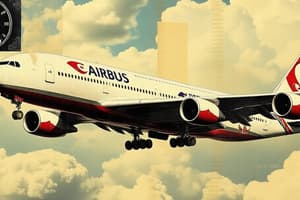Podcast
Questions and Answers
What is the difference between direct costs and indirect costs?
What is the difference between direct costs and indirect costs?
Direct costs are directly related to the creation of a product and can be directly associated with that product, whereas indirect costs are not directly linked to a specific product.
How do direct costs impact product pricing?
How do direct costs impact product pricing?
Direct costs influence the product's price as they are calculated per project or unit, directly affecting the final cost of the product.
How do indirect costs impact the business?
How do indirect costs impact the business?
Indirect costs impact the entire business since they are calculated monthly or annually, affecting the overall operational expenses.
What is the primary factor that influences the variability of direct costs?
What is the primary factor that influences the variability of direct costs?
Give two examples of direct costs.
Give two examples of direct costs.
Where are direct costs reflected in the income statement?
Where are direct costs reflected in the income statement?
What is the primary focus of cost accounting?
What is the primary focus of cost accounting?
What are three key activities carried out by cost accounting?
What are three key activities carried out by cost accounting?
Explain how cost accounting aids in managerial decision-making.
Explain how cost accounting aids in managerial decision-making.
What are some examples of expenses?
What are some examples of expenses?
What is the meaning of the term 'cost' in cost accounting?
What is the meaning of the term 'cost' in cost accounting?
What is a direct cost?
What is a direct cost?
Explain how factory rent would be classified in terms of cost terminology.
Explain how factory rent would be classified in terms of cost terminology.
What are three stages at which cost accounting tracks costs?
What are three stages at which cost accounting tracks costs?
Why is understanding cost behavior important in cost accounting?
Why is understanding cost behavior important in cost accounting?
How does cost accounting help companies control costs?
How does cost accounting help companies control costs?
Provide an example of an indirect cost that is also considered overhead.
Provide an example of an indirect cost that is also considered overhead.
Explain the relationship between overhead and indirect costs.
Explain the relationship between overhead and indirect costs.
Why is accurate cost information essential for successful pricing strategies?
Why is accurate cost information essential for successful pricing strategies?
Give an example of a direct cost associated with a specific product.
Give an example of a direct cost associated with a specific product.
Why is it important to distinguish between direct and indirect costs?
Why is it important to distinguish between direct and indirect costs?
What is one reason why cost accounting is important for making pricing decisions?
What is one reason why cost accounting is important for making pricing decisions?
Explain how cost accounting can be utilized for cost control.
Explain how cost accounting can be utilized for cost control.
How can cost accounting be used to evaluate departmental performance?
How can cost accounting be used to evaluate departmental performance?
What are two key applications of cost accounting in the context of budgeting and forecasting?
What are two key applications of cost accounting in the context of budgeting and forecasting?
Describe how cost accounting supports product mix decisions.
Describe how cost accounting supports product mix decisions.
Explain the relevance of cost accounting in the context of make-or-buy decisions.
Explain the relevance of cost accounting in the context of make-or-buy decisions.
What is the role of cost accounting in investment decisions?
What is the role of cost accounting in investment decisions?
Give an example of how cost accounting can be used to evaluate employee productivity.
Give an example of how cost accounting can be used to evaluate employee productivity.
Flashcards
Pricing Decisions
Pricing Decisions
Identify costs to establish profitable selling prices.
Cost Control
Cost Control
Assess and improve efficiency in operations to reduce costs.
Performance Evaluation
Performance Evaluation
Analyze the effectiveness of departments or processes.
Budgeting and Forecasting
Budgeting and Forecasting
Signup and view all the flashcards
Product Mix Decisions
Product Mix Decisions
Signup and view all the flashcards
Make-or-Buy Decisions
Make-or-Buy Decisions
Signup and view all the flashcards
Investment Decisions
Investment Decisions
Signup and view all the flashcards
Employee Productivity Evaluation
Employee Productivity Evaluation
Signup and view all the flashcards
Cost Accounting
Cost Accounting
Signup and view all the flashcards
Cost Behavior Analysis
Cost Behavior Analysis
Signup and view all the flashcards
Cost Accumulation
Cost Accumulation
Signup and view all the flashcards
Cost Allocation
Cost Allocation
Signup and view all the flashcards
Key Cost Terminology
Key Cost Terminology
Signup and view all the flashcards
Monetary Value of Resources
Monetary Value of Resources
Signup and view all the flashcards
Managerial Decision-Making
Managerial Decision-Making
Signup and view all the flashcards
Production Costs
Production Costs
Signup and view all the flashcards
Raw Materials
Raw Materials
Signup and view all the flashcards
Labor
Labor
Signup and view all the flashcards
Factory Rent
Factory Rent
Signup and view all the flashcards
Expense
Expense
Signup and view all the flashcards
Direct Cost
Direct Cost
Signup and view all the flashcards
Indirect Cost
Indirect Cost
Signup and view all the flashcards
Overhead
Overhead
Signup and view all the flashcards
Depreciation
Depreciation
Signup and view all the flashcards
Calculation Frequency
Calculation Frequency
Signup and view all the flashcards
Impact on Pricing
Impact on Pricing
Signup and view all the flashcards
Cost Variability
Cost Variability
Signup and view all the flashcards
Included in Statements
Included in Statements
Signup and view all the flashcards
Examples of Direct Costs
Examples of Direct Costs
Signup and view all the flashcards
Examples of Indirect Costs
Examples of Indirect Costs
Signup and view all the flashcards
Study Notes
Module 1: Fundamentals of Costing
- This module covers the introduction to cost accounting, cost behavior analysis, and cost accumulation and allocation.
Section 1: Introduction to Cost Accounting
- Cost accounting is a branch of accounting focusing on the costs of production and services.
- It tracks, analyzes, and controls costs at various stages.
- Cost accounting provides crucial data for managerial decision-making.
Key Cost Terminology
- Cost: The monetary value of resources used in producing goods or services. Examples include raw materials, labor, and factory rent.
- Expense: The cost of resources used in generating revenue. Examples include salaries, marketing costs, and utilities.
- Direct Cost: Costs directly traceable to a specific product or service. Examples include raw materials used in a specific product.
- Indirect Cost: Costs that cannot be directly traced to a specific product or service. Examples include factory rent, utilities, and salaries.
- Overhead: Indirect costs associated with production. Example: depreciation.
Direct vs Indirect Cost
- Direct costs are directly related to the creation of a product and can be directly associated with that product.
- Indirect costs are not directly related to a specific cost object.
Direct Cost Characteristics
- Affects the product's price, calculated per product or unit.
- Product volume affects final product costs.
- Highly variable, mainly due to market factors.
- Includes raw materials, manufacturing, and direct labor.
- Included in the cost of goods sold in the income statement.
Indirect Cost Characteristics
- Affects the entire business, calculated monthly or annually.
- Changes in production volume do not significantly affect indirect costs.
- Relatively stable.
- Includes rents, leases, utilities, insurance, legal fees, office expenses, maintenance, and telecommunications.
- Included in operational expenses in the income statement.
Purpose of Cost Accounting
- Pricing Decisions: Determine the cost to set profitable prices.
- Cost Control: Identify areas for efficiency improvements.
- Performance Evaluation: Assess the efficiency of departments/processes.
- Budgeting and Forecasting: Plan future costs and resource allocation.
- Product Mix Decisions: Evaluate the profitability of different products.
- Make-or-buy Decisions: Determine whether to manufacture internally or outsource.
- Investment Decisions: Evaluate the profitability of capital investments.
Cost Accounting in Managerial Decision-Making
- Examples include: evaluating employee productivity, identifying areas for cost reduction, and choosing suppliers.
Different Costing Methods
- Job Order Costing
- Process Costing
- Activity-Based Costing
Studying That Suits You
Use AI to generate personalized quizzes and flashcards to suit your learning preferences.




